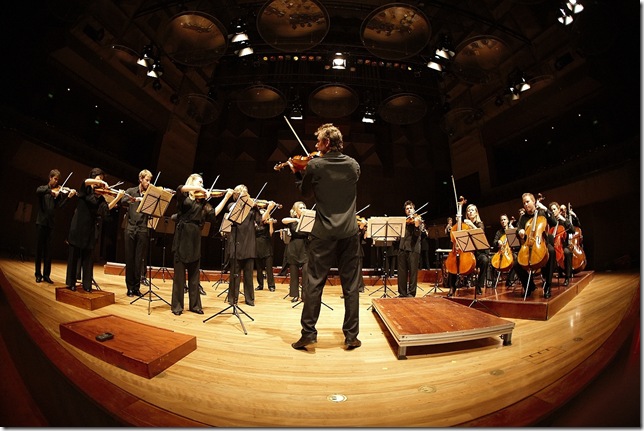By Robert Croan
Water, a new classical work by Radiohead’s Jonny Greenwood, is the centerpiece of the Australian Chamber Orchestra’s current tour program, which reached Broward Center’s Au-Rene Theater on Wednesday for a rewarding, if sparsely attended, event.
This versatile rock group guitarist has written classical music before this, as well as film scores and a collaboration with composer Krzysztof Penderecki. The present piece, sandwiched between two Mozart classics, was a resounding success in the excellent Broward performance.
Having visited India and taken some techniques from India’s classical music, Greenwood created a vibrant and colorful 18-minute opus, quite unlike anything else we’re likely to hear in new symphonic repertory, but not jarringly unusual in the context of a classical concert.
The Indian influence is manifested not only in the use of a tanpura (a non-fretted long-necked lute-like instrument with a lovely, delicate sound, impressively played here by Vinod Prassana); but also the integral use of an ostinato, a repeated underlying musical phrase that resembles but does not imitate an Indian raga. The original score required two tanpuras, but their parts were consolidated into a single instrument (with some electronic aid) for the tour.
Greenwood successfully integrated the Asian and Western elements in this score, so that they go from one to the other smoothly. The main part of his orchestra is the traditional string section, exploring at times untraditional techniques — among them, bowing behind the bridge, striking strings with a guitar plectrum and sustained high harmonics. Taking its title from the imagery in a poem by Philip Larkin (“where any angled light would congregate endlessly”), Water was an altogether engaging outing.
The Australian Chamber Orchestra, 27 members at its fullest, is an ensemble of virtuoso soloists who perform in precise togetherness when called for (as in a Mozart symphony) yet maintain individuality when called for by the music. Richard Tognetti, artistic director and lead violin for the past 25 years, sometimes conducts when he is not playing, or may release that task to another member when he is playing. The system works splendidly. In the traditional Mozart pieces, several individuals appeared to have their parts memorized, allowing them to interrelate in ways not possible in standard symphonic situations.
Soloist for the evening was clarinetist Sharon Kam, replacing originally scheduled Swedish virtuoso Martin Fröst, who withdrew from the tour due to a shoulder injury. The Israeli-born Kam proved herself no less stellar on her own merits, pleasing with a delicious rendition of Mozart’s Clarinet Concerto that made the work’s highly difficult solo part sound like fun, while conveying a theatrical quality that had the impact of a one-woman opera.
Kam made use of the color and register possibilities of her instrument to show off the way the modern clarinet can suggest contrasting characteristics and dramatic effects. This was Mozart’s last purely instrumental work, a bit experimental because the clarinet was a relatively new instrument at that time, and Kam took every opportunity to focus on its possibilities.
Her soprano top-sound engaged in quirky duets with her baritonal low register, even merging into a soprano-tenor baritone trio in the adagio movement; she relished in what came through as natural conversation, the give-and-take now and then developing into a bit of an argument. There was humanity and humor throughout, along with a sense of how much this accomplished and very likable performer delights in showing her mettle.
Mozart’s Symphony No. 40, in a thoughtful and highly nuanced rendition by ACO, was a revelation, suggesting what this music might have sounded like when it was written. The small forces actually added gravitas to this most serious of Mozart’s symphonies, in transparency of textures and interaction with the listener. Tempos were brisk, rhythms had strong accent, and the drama increased with each movement.
By the time these players arrived at the finale, the slashing bow strokes were almost painful in their intensity. Each episode conveyed a tangible mood. As an encore, ACO played the finale of Mozart’s early Symphony No. 29 — to show, in Tognetti’s words, “that Mozart didn’t develop,” that his genius was there from the start.
Least successful was the opening work of the evening, an arrangement for string orchestra of Prokofiev’s collection of piano pieces — Visions fugitives — by the late Russian conductor and violist Rudolf Barshai. In their original keyboard setting, these minuscule pieces (each lasting approximately a minute or less) have sharp profile and immediacy.
Barshai’s transformation for strings allowed the orchestra to warm up and show various aspects of string playing technique, but the result lacked crispness and too often, accuracy of intonation. The loud and fast segments fared better than the soft and sustained, which tended to droop in rhythm and pitch.
